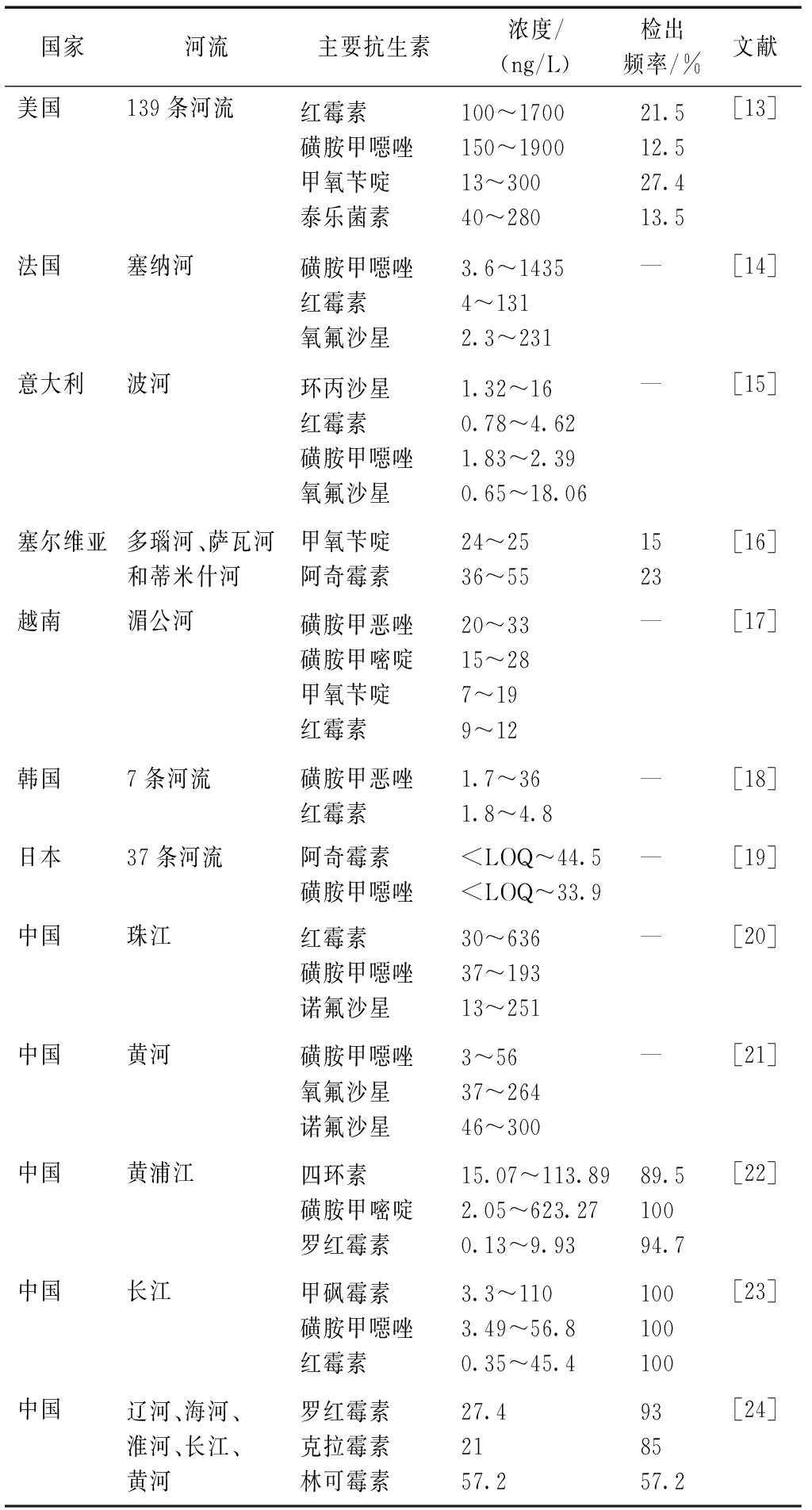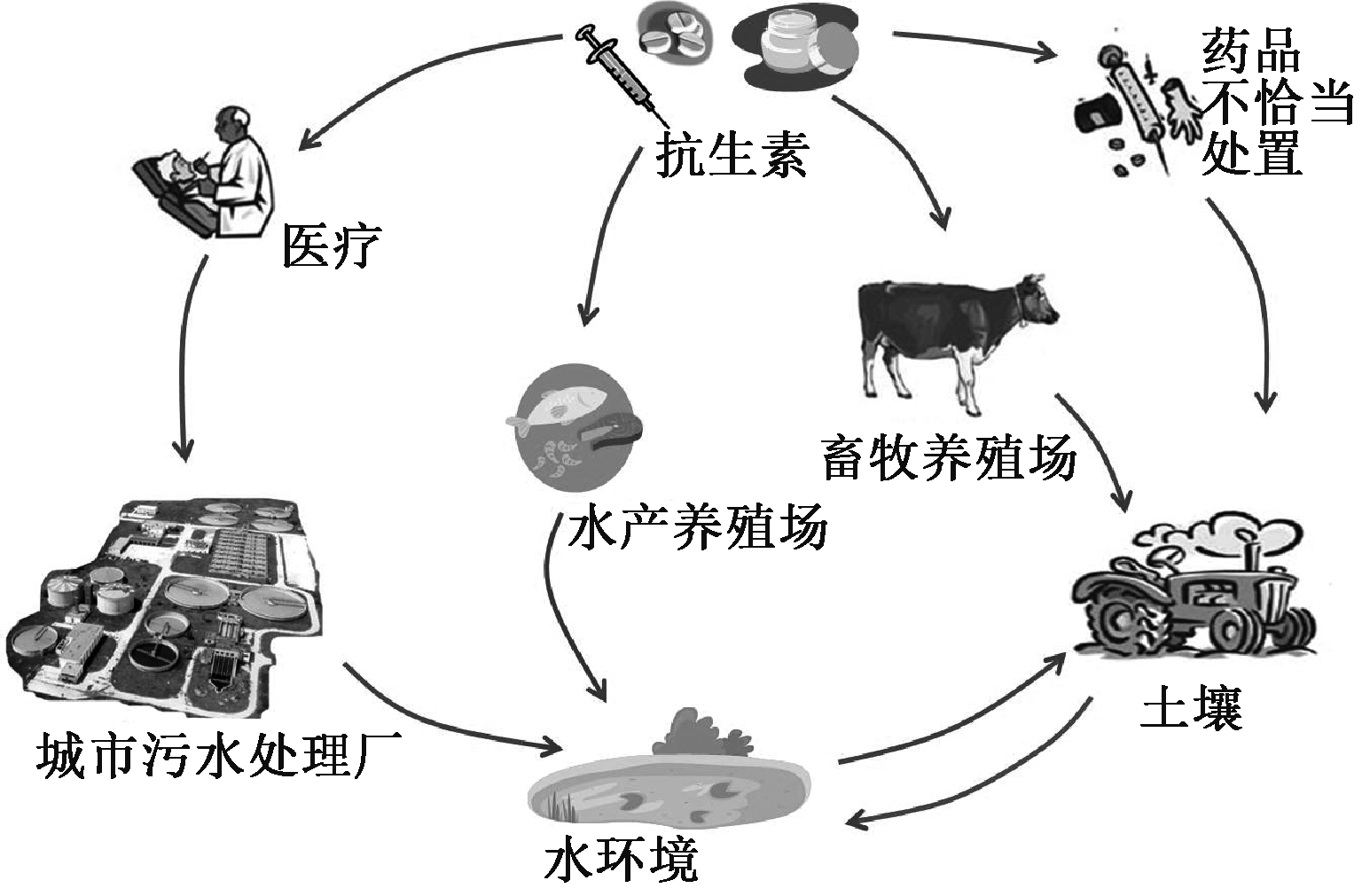0 引 言
近年来,抗生素作为一类新兴有机污染物在自然水环境中的出现引起了国内学者的广泛关注[1-3]。抗生素作为治疗感染性疾病的药物,其使用广泛且用量较大。然而,抗生素进入人体或动物体内之后,有5%~90%是以母体结构形态或代谢产物形态通过尿液或粪便排出体外[1,4]。例如,30%的诺氟沙星和70%的氧氟沙星未能代谢而从尿液中排出体外[5];55%的罗红霉素和65%的阿奇霉素以母体结构形态经由粪便排出体外[6]。因此,抗生素的大量使用容易导致其通过直接或间接的途径进入环境,进而造成环境污染、危害生物体健康。
目前,世界诸多地区的自然水环境中已检测到抗生素的存在,它们对环境中生物体造成的潜在不利影响已引起研究者的高度重视,相关研究已经展开。本文综述了近几年国内外不同地区的自然水环境中抗生素的污染状况,同时分析了抗生素出现在环境中的主要来源。另外,基于目前已有研究成果对抗生素造成的环境危害进行了综述,以期加强对自然水环境中抗生素污染的认识,同时希望能为进一步开展抗生素环境风险评估及污染减排控制等研究提供参考。
1 自然水环境中抗生素的污染现状
抗生素类药物使用范围广、用量较大,导致其在自然水环境中出现的概率较大。诸多国内外的研究报道指出,自然水环境中已经检测出多种抗生素,包括海洋、河流、湖泊和地下水等自然水体。
1.1 海洋中的抗生素
海洋是地球上最辽阔的水体,是自然水体的最主要组成部分,海洋中拥有种类繁多的生物,其生态系统极为庞大。抗生素类污染物对海洋的污染不容忽视。诸多研究考察了国内外一些海域中抗生素的污染状况,如表1所示,其检出浓度为0.3~73722 ng/L。虽然其浓度处于纳克级、微克级水平,但抗生素种类繁多,目前的大部分研究所考察的抗生素种类有限,并不能反映出水体中抗生素的实际污染状况,因此也很难评估其真实危害,这也正是当前研究所需要突破的地方。
表1 国内外海域中抗生素的污染现状
Table 1 The pollution of antibiotics in different sea areas

国家海域主要抗生素浓度/(ng/L)检出频率/%文献比利时大西洋东部北海海湾磺胺甲噁唑甲氧苄啶13~9613~29—[7]伊朗波斯湾阿奇霉素诺氟沙星四环素0.3~4.819~684.0~71100100100[8]哥斯达黎加哥斯达黎加沿海海域强力霉素苯甲异噁唑青霉素诺氟沙星74~7372270~757138~174477228[9]中国维多利亚海湾红霉素氧氟沙星甲氧苄啶阿莫西林4.7~17308.1~11402.6~2160.64~7610010050100[10]中国黄海南部海域磺胺甲噁唑红霉素氟苯尼考n.d.~48n.d.~1.7n.d.~42577053[11]中国渤海北部海域磺胺甲噁唑氧氟沙星诺氟沙星红霉素3~1403~51003~68004~15097555587[12]
注:n.d.表示未检出,下同。
1.2 河流中的抗生素
河流是地球淡水资源的重要组成部分,是人类活动用水如工业用水和饮用水等的主要来源之一,其水质不仅对河流生态系统中的生物有影响,还对工农业生产与人体健康具有直接影响。抗生素类污染物对河流的污染同样关系到河流生态系统健康、人体健康等,因此引起了广泛关注。如表2所示,依据已有文献报道,国内外的许多河流中已检测到多种抗生素,其浓度为0.13~1900 ng/L。我国的重要河流,如长江、黄河、珠江等,均检测到抗生素类污染物。
表2 国内外河流中抗生素的污染现状
Table 2 The pollution of antibiotics in different rivers

国家河流主要抗生素浓度/(ng/L)检出频率/%文献美国139条河流红霉素磺胺甲噁唑甲氧苄啶泰乐菌素100~1700150~190013~30040~28021.512.527.413.5[13]法国塞纳河磺胺甲噁唑红霉素氧氟沙星3.6~14354~1312.3~231—[14]意大利波河环丙沙星红霉素磺胺甲噁唑氧氟沙星1.32~160.78~4.621.83~2.390.65~18.06—[15]塞尔维亚多瑙河、萨瓦河和蒂米什河甲氧苄啶阿奇霉素24~2536~551523[16]越南湄公河磺胺甲恶唑磺胺甲嘧啶甲氧苄啶红霉素20~3315~287~199~12—[17]韩国7条河流磺胺甲恶唑红霉素1.7~361.8~4.8—[18]日本37条河流阿奇霉素磺胺甲噁唑
注:LOQ表示定量限,下同。
1.3 湖泊与地下水中的抗生素
湖泊与地下水都是地球上重要的淡水资源,诸多研究表明,一些地区的湖泊与地下水均受到抗生素类污染物的污染,部分报道如表3与表4所示。安大略湖、密歇根湖、我国的太湖、青山湖等均检测出抗生素,浓度为0.05~940 ng/L。地下水中抗生素的浓度为0.57~503 ng/L。从所涉及的文献看,湖泊与地下水中抗生素的浓度要比河流与海洋中的值低,这可能是由于人类活动在海洋与河流中较其他水体更频繁所致。
表3 国内外湖泊中抗生素污染情况对比
Table 3 Comparison of the pollution of antibiotics in different lakes

国家湖泊主要抗生素浓度/(ng/L)参考文献加拿大安大略湖甲氧苄啶磺胺嘧啶磺胺甲噁唑0.12~5.510.04~0.580.05~1.4[25]美国密歇根湖磺胺甲噁唑罗红霉素氧氟沙星阿奇霉素4.5~774.5~3910~617.5~22[26]瑞士日内瓦湖环丙沙星诺氟沙星磺胺甲噁唑324514[27]塞尔维亚察加湖甲氧苄啶阿奇霉素17481[16]中国青山湖磺胺甲噁唑甲氧苄啶
表4 国内外地下水中抗生素污染情况对比
Table 4 Comparison of the pollution of antibiotics in groundwater

国家地域主要抗生素浓度/(ng/L)检出频率/%参考文献美国华盛顿州磺胺甲嘧啶磺胺地索辛76~22046~68—[31]美国蒙大纳州海伦娜谷地区磺胺甲噁唑甲氧苄啶0.57~4901.1~3.17810[32]中国天津环丙沙星氯霉素磺胺多辛31.8~42.55.8~28.178.3—[33]中国北京、天津、上海等氧氟沙星诺氟沙星红霉素磺胺甲噁唑
2 水环境中抗生素的来源
通过上文可看出,全球许多地区的海洋、河流、湖泊、地下水等水体中均检测出抗生素,可见抗生素类污染物对于自然水体的污染具有普遍性。本文通过总结已发表文献,归纳了抗生素进入自然水体的主要途径包括污水处理厂、水产养殖场、畜牧养殖场和药品不恰当丢弃。图1展示了抗生素进入自然水环境的途径。

图1 抗生素进入自然环境的途径示意
Figure 1 The pathways of antibiotics entering into the natural aquatic environment
2.1 污水处理厂
抗生素在生物体内只有一部分能够代谢,据Kümmerer[35]报道,10%~90%的抗生素经生物体后以母体结构形式由尿液及粪便排出,随后随污水进入污水处理厂。然而,目前大部分污水处理厂所采用的生物法污水处理工艺并不能有效去除污水中的抗生素[36],这是由于大部分抗生素的可生化降解性较差。本文总结了4类常用抗生素在不同污水处理厂的去除效果,如表5所示。可知:不同种类的抗生素,其去除率不尽相同,这与抗生素自身的物理化学性质有关。大环内酯类抗生素的去除率普遍偏低,可能是由于该类抗生素结构稳定不易被破坏。喹诺酮类抗生素与磺胺类抗生素的去除率波动较大,这与不同污水处理厂所用处理工艺不同有关。总体而言,这2类抗生素的去除率处于中等水平。β-内酰胺类抗生素的去除率均较高,可能是由于该类抗生素稳定性较差,容易被微生物所分泌的某些酶水解[37]。另外,不同污水处理工艺对抗生素的去除效果不同,传统活性污泥法对抗生素的去除效果较差,而膜生物反应器工艺对抗生素的去除效果相对较好。总之,抗生素在污水处理厂的去除率与其自身物理化学性质和污水处理工艺有关,但大部分抗生素的去除效果并不理想,从而导致其随出水进入排放海域或河流。可见,污水处理厂出水是自然水环境中抗生素重要来源之一。
2.2 水产养殖场与畜牧养殖场
抗生素除了用于医治人体或动物体疾病之外,还普遍被用于动物饲养添加剂以保障动物健康及快速生长,这在水产养殖场与畜牧养殖场应用较为广泛。据报道,美国平均每年约生产22700 t抗生素,其中约有50%用于水产养殖业与畜牧养殖业[35]。
表5 不同种类抗生素在污水处理厂污水中的浓度及去除率
Table 5 Concentrations and removal efficiencies of different kinds of antibiotics in WWTPs

类别国家污水处理工艺主要抗生素浓度/(ng/L)进水出水去除率/%参考文献大环内酯类抗生素意大利传统活性污泥法克拉霉素红霉素319121457255-5[15]日本传统活性污泥法克拉霉素阿奇霉素6472603591384349[38]中国循环式活性污泥法,传统活性污泥法罗红霉素阿奇霉素145301276435-149-150[39]西班牙膜生物反应器传统活性污泥法红霉素红霉素————67.323.8[40]喹诺酮类抗生素意大利传统活性污泥法环丙沙星氧氟沙星5134631481917159[15]日本传统活性污泥法左氧氟沙星55230142[38]中国循环式活性污泥法,传统活性污泥法氧氟沙星诺氟沙星3303801961383657[39]西班牙膜生物反应器传统活性污泥法氧氟沙星氧氟沙星————9423.8[40]澳大利亚传统活性污泥法环丙沙星诺氟沙星3800170640858385[41]磺胺类抗生素意大利传统活性污泥法磺胺甲噁唑24610159[15]西班牙膜生物反应器传统活性污泥法磺胺甲噁唑磺胺甲噁唑————60.555.6[40]美国传统活性污泥法磺胺甲噁唑磺胺甲嘧啶磺胺地索辛1090100200210
淡水养殖场一般建造在河流、湖泊附近,海水养殖场常建造于近海岸海域中,因此养殖场中抗生素的使用通常会对附近地表水产生影响。Minh等[10]在其研究中考察了维多利亚海湾中抗生素的分布情况,发现海域中土霉素和磺胺甲嘧啶的检出浓度较高,推测是受到了该海域附近水产养殖场的影响。Zou等[12] 研究我国渤海海湾中抗生素分布情况时发现,所考察海域中抗生素的来源主要有入海河流及附近水产养殖场排放的废水。
畜牧养殖场中动物所食用的抗生素只有部分被代谢,大部分以母体结构随排泄物排出,从而进入环境中。有研究表明,若金霉素添加于牛饲料中的量为70 mg/(头·d)时,牛粪便中金霉素含量为14 μg/g[43]。
3 自然水环境中抗生素的危害
虽然抗生素在自然水环境中的浓度相对较低,但其对生态系统及人类健康的潜在危害不容忽视。随着抗生素在自然水环境中被频繁检出,针对其危害的研究也越来越多。根据已有文献报道,自然水环境中抗生素的危害可归结为3个方面,即生物毒性、诱导抗药菌或抗药基因、威胁饮用水安全性。下面分别从3个方面展开论述:
1)作为抑制微生物生长的药物,抗生素对于某些生物,特别是微生物的生长有不利影响。目前已有诸多文献报道自然水环境中的抗生素对某些生物具有毒性作用,从而影响其正常生长或繁殖。例如,Andreozzi等[44]研究了自然水体中痕量阿莫西林对藻类的毒性作用,发现阿莫西林对蓝藻门聚球藻属的S. leopoliensis藻具有较强的毒性作用,该抗生素对该藻类的无观察效应浓度(no observed effect concentration, NOEC)、最低观察效应浓度(lowest observed effect concentration, LOEC)和半最大效应浓度(EC50)分别为0.78,1.56,2.22 μg/L级。另外,值得注意的是,目前针对抗生素类污染物的毒性或风险评估通常是在单一抗生素条件下开展,然而在实际水环境中,抗生素往往是以多种药物混合共存的形式存在,协同作用可能产生比单一抗生素更强的毒性[45]。Backhaus等[46]研究了包括抗生素在内的26种痕量药物混合物在污水处理厂出水中的环境风险,结果表明,该药物混合物的环境风险值是任何单一药物环境风险值的1000倍以上,可见混合药物的危害远大于单一药物。
2)自然水环境中的抗生素能够诱导抗药菌或抗药基因的产生。Luo等[47]研究了天津市海河中磺胺类抗生素与抗药性基因产生的相关性,结果表明,河流中磺胺类抗生素抗药基因(如sul1/16S-rDNA 和sul2/16S-rDNA)的相对丰度与河流中磺胺类抗生素的浓度呈正相关性。Jiang等[48]的研究得出了类似的结论:黄埔江中2种磺胺类抗药基因和8种四环素抗药基因浓度与河流中残留磺胺类抗生素和四环素浓度呈正相关性。
3)抗生素类污染物可能威胁饮用水的安全性。饮用水水源可能被抗生素污染,若净水厂不能将抗生素去除,其将进入饮用水管网。Benotti等[49]考察了美国19所净水厂的进水、出水和住宅区管网自来水中多种药物类污染物的污染情况,研究表明,17所净水厂的进水中均含有磺胺甲噁唑,最高浓度为110 ng/L(平均浓度为12 ng/L);11所水厂的进水中含有甲氧苄啶,最高浓度为11 ng/L(平均浓度为0.8 ng/L);4所净水厂出水中检测到磺胺甲噁唑,最高浓度为3 ng/L(平均浓度为0.39 ng/L);1所净水厂的住宅区管网自来水中检测出磺胺甲噁唑,浓度为0.32 ng/L。
4 结语与展望
综合来看,抗生素在近海海域和河流中的检出频率和浓度均高于湖泊和地下水中的值,这可能是由于人类活动以及污水排入海洋与河流中较其他水体更频繁所致。污水处理厂出水是自然水环境中抗生素的重要来源之一,而抗生素在污水处理厂的去除率与自身物理化学性质和污水处理工艺有关。自然水体中抗生素的环境危害已得到科学证实。目前,针对该领域的研究方兴未艾,尚待完善的研究方向有如下几方面:加强对环境中多种抗生素联合毒性效应及风险评估研究;加强抗生素在多介质环境中的迁移与转化研究;加强针对污水处理厂出水中抗生素等新兴污染物减排控制优势工艺研究;加强抗生素在饮用水水源水及自来水中健康风险评估研究。
[1] MIRZAEI R, YUNESIAN M, NASSERI S, et al. Occurrence and fate of most prescribed antibiotics in different water environments of tehran, iran [J]. Science of the Total Environment, 2018, 619/620:446-459.
[2] LI S, SHI W Z, LIU W, et al. A duodecennial national synthesis of antibiotics in China’s major rivers and seas (2005—2016) [J]. Science of the Total Environment, 2018, 615:906-917.
[3] HU Y, YAN X, SHEN Y, et al. Antibiotics in surface water and sediments from hanjiang river, central china: occurrence, behavior and risk assessment [J]. Ecotoxicology and Environment Safety, 2018, 157:150-158.
[4] DINH Q T, ALLIOT F, MOREAU-GUIGON E, et al. Measurement of trace levels of antibiotics in river water using on-line enrichment and triple-quadrupole lc-ms/ms [J]. Talanta, 2011, 85(3): 1238-1245.
[5] FILLASTRE J P, LEROY A, HUMBERT G. Ofloxacin pharmacokinetics in renal failure [J]. Antimicrobial Agents and Chemotherapy, 1987, 31(2): 156-160.
[6] VANDERHAEGHE H, HOOGMARTENS J. Macrolides: Chemistry, Pharmacology and Clinical Uses[M]. Arnette Blackwell: Paris, 1993.
[7] WILLE K, NOPPE H, VERHEYDEN K, et al. Validation and application of an lc-ms/ms method for the simultaneous quantification of 13 pharmaceuticals in seawater [J]. Analytical and Bioanalytical Chemistry, 2010, 397(5): 1797-1808.
[8] KAFAEI R, PAPARI F, SEYEDABADI M, et al. Occurrence, distribution, and potential sources of antibiotics pollution in the water-sediment of the northern coastline of the persian gulf, iran [J]. Science of the Total Environment, 2018, 627:703-712.
[9] SPONGBERG A L, WITTER J D, ACU A J, et al. Reconnaissance of selected ppcp compounds in costa rican surface waters [J]. Water Research, 2011, 45(20): 6709-6717.
A J, et al. Reconnaissance of selected ppcp compounds in costa rican surface waters [J]. Water Research, 2011, 45(20): 6709-6717.
[10] MINH T B, LEUNG H W, LOI I H, et al. Antibiotics in the hong kong metropolitan area: ubiquitous distribution and fate in victoria harbour [J]. Marine Pollution Bulletin, 2009, 58(7): 1052-1062.
[11] DU J, ZHAO H X, LIU S S, et al. Antibiotics in the coastal water of the south Yellow Sea in China: occurrence, distribution and ecological risks [J]. Science of the Total Environment, 2017, 595:521-527.
[12] ZOU S C, XU W H, ZHANG R J, et al. Occurrence and distribution of antibiotics in coastal water of the Bohai Bay, China: Impacts of river discharge and aquaculture activities [J]. Environmental Pollution, 2011, 159(10): 2913-2920.
[13] KOLPIN D W, FURLONG E T, MEYER M T, et al. Pharmaceuticals, hormones, and other organic wastewater contaminants in U.S. streams, 1999—2000: a national reconnaissance [J]. Environmental Science & Technology, 2002, 36(6): 1202-1211.
[14] TUC D Q, ALLIOT F, MOREAU-GUIGON E, et al. Measurement of trace levels of antibiotics in river water using on-line enrichment and triple-quadrupole lc-ms/ms [J]. Talanta, 2011, 85(3): 1238-1245.
[15] ZUCCATO E, CASTIGLIONI S, BAGNATI R, et al. Source, occurrence and fate of antibiotics in the italian aquatic environment [J]. Journal of Hazardous Materials, 2010, 179(1/2/3): 1042-1048.
![]() M. Determination of multiple pharmaceutical classes in surface and ground waters by liquid chromatography-ion trap-tandem mass spectrometry [J]. Journal of Chromatography A, 2009, 1216(25): 4989-5000.
M. Determination of multiple pharmaceutical classes in surface and ground waters by liquid chromatography-ion trap-tandem mass spectrometry [J]. Journal of Chromatography A, 2009, 1216(25): 4989-5000.
[17] MANAGAKI S, MURATA A, TAKADA H, et al. Distribution of macrolides, sulfonamides, and trimethoprim in tropical waters: ubiquitous occurrence of veterinary antibiotics in the Mekong delta [J]. Environmental Science & Technology, 2007, 41(23): 8004-8010.
[18] KIM S D, CHO J, KIM IN S, et al. Occurrence and removal of pharmaceuticals and endocrine disruptors in south Korean surface, drinking, and waste waters [J]. Water Research, 2007, 41(5): 1013-1021.
[19] MURATA A, TAKADA H, MUTOH K, et al. Nationwide monitoring of selected antibiotics: distribution and sources of sulfonamides, trimethoprim, and macrolides in Japanese rivers [J]. Science of the Total Environment, 2011, 409(24): 5305-5312.
[20] XU W H, ZHANG G, ZOU S C, et al. Determination of selected antibiotics in the victoria harbour and the pearl river, south China using high-performance liquid chromatography-electrospray ionization tandem mass spectrometry [J]. Environmental Pollution, 2007, 145(3): 672-679.
[21] XU W H, ZHANG G, ZOU S C, et al. A preliminary investigation on the occurrence and distribution of antibiotics in the Yellow River and its tributaries, China [J]. Water Environment Research, 2009, 81(3): 248-254.
[22] JIANG L, HU X L, YIN D Q, et al. Occurrence, distribution and seasonal variation of antibiotics in the Huangpu River, Shanghai, China [J]. Chemosphere, 2011, 82(6): 822-828.
[23] YAN C X, YANG Y, ZHOU J L, et al. Antibiotics in the surface water of the yangtze estuary: occurrence, distribution and risk assessment [J]. Environmental Pollution, 2013, 175: 22-29.
[24] SUN J, LUO Q, WANG D H, et al. Occurrences of pharmaceuticals in drinking water sources of major river watersheds, China [J]. Ecotoxicology and Environmental Safety, 2015, 117: 132-140.
[25] LI H X, HELM P A, METCALFE C D. Sampling in the great lakes for pharmaceuticals, personal care products, and endocrine-disrupting substances using the passive polar organic chemical integrative sampler [J]. Environmental Toxicology and Chemistry, 2010, 29(4): 751-762.
[26] BLAIR B D, CRAGO J P, HEDMAN C J, et al. Pharmaceuticals and personal care products found in the great lakes above concentrations of environmental concern [J]. Chemosphere, 2013, 93(9): 2116-2123.
[27] MORASCH B, BONVIN F, REISER H, et al. Occurrence and fate of micropollutants in the vidy bay of lake geneva, Switzerland. Part ii: micropollutant removal between wastewater and raw drinking water [J]. Environmental Toxicology and Chemistry, 2010, 29(8): 1658-1668.
[28] ZHU S C, CHEN H, LI J N. Sources, distribution and potential risks of pharmaceuticals and personal care products in Qingshan Lake Basin, Eastern China [J]. Ecotoxicology and Environmental Safety, 2013, 96: 154-159.
[29] LIU X H, LU S Y, GUO W, et al. Antibiotics in the aquatic environments: a review of lakes, China [J]. Science of the Total Environment, 2018, 627:1195-1208.
[30] LU G H, YANG X F, LI Z H, et al. Contamination by metals and pharmaceuticals in northern Taihu Lake (China) and its relation to integrated biomarker response in fish [J]. Ecotoxicology, 2013, 22(1): 50-59.
[31] BATT A L, SNOW D D, AGA D S. Occurrence of sulfonamide antimicrobials in private water wells in Washington County, idaho, USA [J]. Chemosphere, 2006, 64(11): 1963-1971.
[32] KATHLEEN J. Miller Joseph Meek, Helena Valley Ground Water: Pharmaceuticals, Personal Care Products, Endocrine Disruptors (PPCPs), and Microbial Indicators of Fecal Contamination[R]. Montana Bureau of Mines and Geology Open-File Report 532: 2006.
[33] HU X G, ZHOU Q X, LUO Y. Occurrence and source analysis of typical veterinary antibiotics in manure, soil, vegetables and groundwater from organic vegetable bases, northern China [J]. Environmental Pollution, 2010, 158(9): 2992-2998.
[34] MA Y P, LI M, WU M M, et al. Occurrences and regional distributions of 20 antibiotics in water bodies during groundwater recharge[J]. Science of the Total Environment, 2015, 518/519: 498-506.
[35] KÜMMERER K. Antibiotics in the aquatic environment: a review-Part Ⅰ[J]. Chemosphere, 2009, 75(4): 417-434.
[36] WATKINSON A J, MURBY E J, KOLPIN D W, et al. The occurrence of antibiotics in an urban watershed: from wastewater to drinking water [J]. Science of the Total Environment, 2009, 407(8): 2711-2723.
[37] CHA J M, YANG S, CARLSON K H. Trace determination of β-lactam antibiotics in surface water and urban wastewater using liquid chromatography combined with electrospray tandem mass spectrometry [J]. Journal of Chromatography A, 2006, 1115(1/2): 46-57.
[38] YASOJIMA M, NAKADA N, KOMORI K, et al. Occurrence of levofloxacin, clarithromycin and azithromycin in wastewater treatment plant in japan [J]. Water Science and Technology, 2006, 53(11): 227-233.
[39] ZHANG H M, LIU P X, FENG Y J, et al. Fate of antibiotics during wastewater treatment and antibiotic distribution in the effluent-receiving waters of the Yellow Sea, northern China [J]. Marine Pollution Bulletin, 2013, 73(1): 282-290.
[40] RADJENOVIC J, PETROVIC M, BARCEL D. Analysis of pharmaceuticals in wastewater and removal using a membrane bioreactor [J]. Analytical and Bioanalytical Chemistry, 2007, 387(4): 1365-1377.
D. Analysis of pharmaceuticals in wastewater and removal using a membrane bioreactor [J]. Analytical and Bioanalytical Chemistry, 2007, 387(4): 1365-1377.
[41] WATKINSON A J, MURBY E J, COSTANZO S D. Removal of antibiotics in conventional and advanced wastewater treatment: implications for environmental discharge and wastewater recycling [J]. Water Research, 2007, 41(18): 4164-4176.
[42] YANG S, CHA J M, CARLSON K. Simultaneous extraction and analysis of 11 tetracycline and sulfonamide antibiotics in influent and effluent domestic wastewater by solid-phase extraction and liquid chromatography-electrospray ionization tandem mass spectrometry [J]. Journal of Chromatography A, 2005, 1097(1/2): 40-53.
[43] SARMAH A K, MEYER M T, BOXALL A B. A global perspective on the use, sales, exposure pathways, occurrence, fate and effects of veterinary antibiotics (vas) in the environment [J]. Chemosphere, 2006, 65(5): 725-759.
[44] ANDREOZZI R, CAPRIO V, CINIGLIA C, et al. Antibiotics in the environment: occurrence in italian stps, fate, and preliminary assessment on algal toxicity of amoxicillin [J]. Environmental Science & Technology, 2004, 38(24): 6832-6838.
[45] GONZALEZ-PLEITER M, GONZALO S, RODEA-PALOMARES I, et al. Toxicity of five antibiotics and their mixtures towards photosynthetic aquatic organisms: implications for environmental risk assessment [J]. Water Research, 2013, 47(6): 2050-2064.
[46] BACKHAUS T, KARLSSON M. Screening level mixture risk assessment of pharmaceuticals in STP effluents [J]. Water Research, 2014, 49: 157-165.
[47] LUO Y, MAO D Q, RYSZ M, et al. Trends in antibiotic resistance genes occurrence in the Haihe River, China [J]. Environmental Science & Technology, 2010, 44(19): 7220-7225.
[48] JIANG L, HU X L, XU T, et al. Prevalence of antibiotic resistance genes and their relationship with antibiotics in the Huangpu River and the drinking water sources, Shanghai, China [J]. Science of the Total Environment, 2013, 458/459/460: 267-272.
[49] BENOTTI M J, TRENHOLM R A, VANDERFORD B J, et al. Pharmaceuticals and endocrine disrupting compounds in U.S. drinking water [J]. Environmental Science & Technology, 2009, 43(3): 597-603.